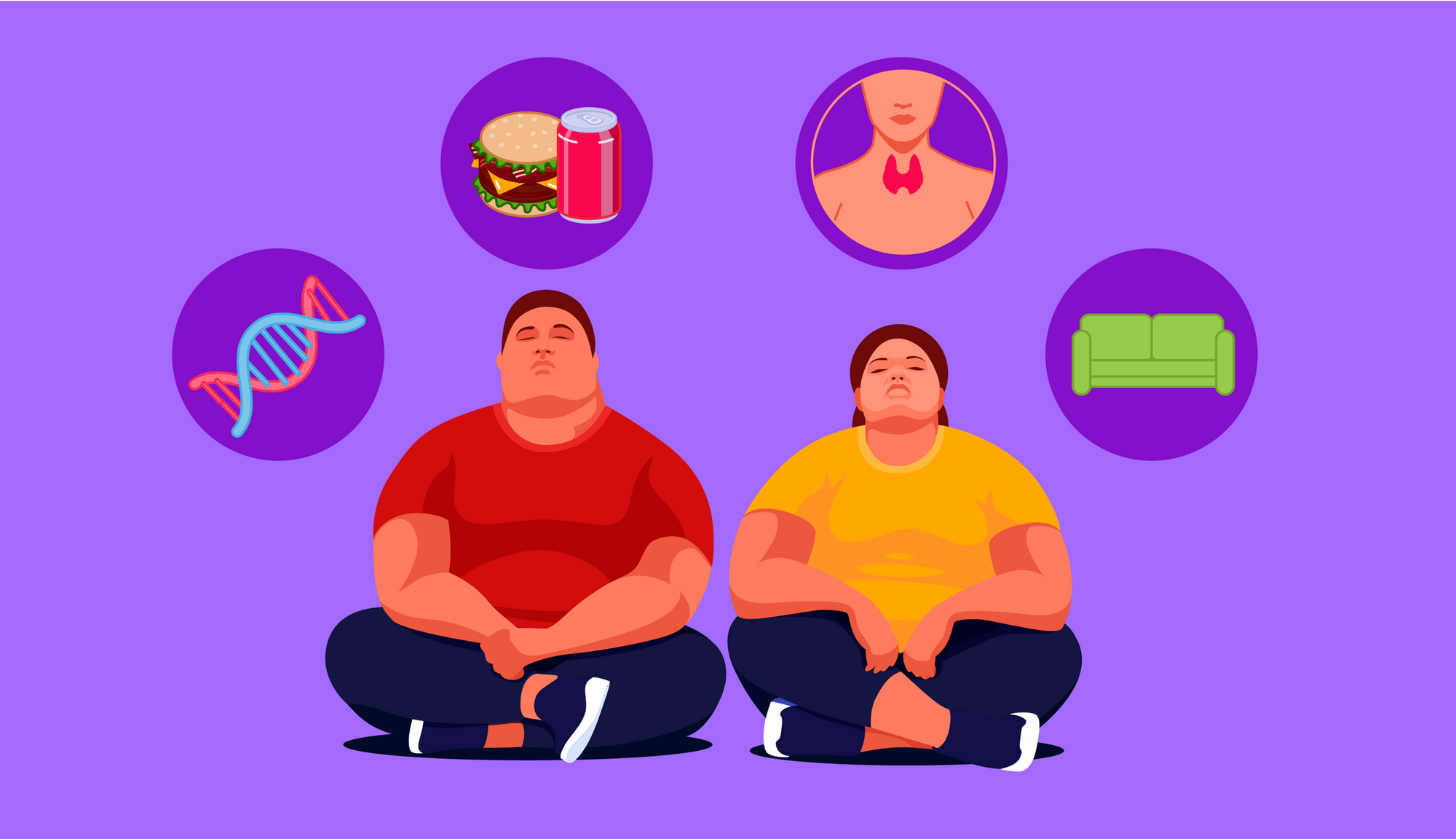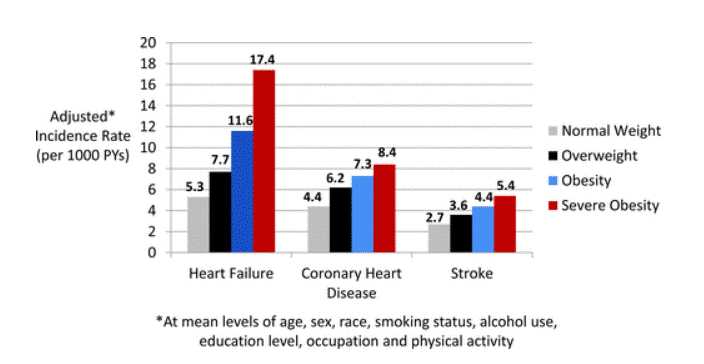The Complexities of Obesity, A modern Perspective Pt.1 What is Obesity?
Reading Time: 15 Minutes
In this blog series I will go over the current literature on the disease known as obesity. For this blog (pt. 1) I will cover exactly what obesity is, the prevalence of this disease, reasons for its occurrence, and the health implications associated with it. Future blogs will cover how to assess obesity and solutions to combat it from a wholistic perspective.
What is Obesity?
The World Health Organization (WHO) defines overweight and obesity as an abnormal or excessive fat accumulation that presents a risk to health. Generally speaking, the short and easy way of determining excess adiposity (body fat) is done via Body Mass Index (BMI), but we’ll go over that in greater detail in pt. 2. For now, just know that the cutoff for overweight is a BMI of 25 - 29.9, and obesity is a BMI of 30+. While this definition is true, I believe it isn’t sufficient in addressing the underlying causes for obesity. You see, excess adiposity is the side effect of certain behaviors, so the question becomes what causes someone to gain excess adiposity. Because of this gap in explanation for the disease provided by the WHO, I prefer the definition provided by the Obesity Medicine Association (OMA) which states that obesity is a chronic, relapsing, multi-factorial, neurobehavioral diseases, wherein an increase in body fat promotes adipose tissue dysfunction and abnormal fat mass physical forces, resulting in adverse metabolic, biomechanical, and psychosocial health consequences. This definition, by my estimation, addresses the root cause of obesity as we currernly understand it. Obesity, contrary to public perception, is caused by a neurobehavioral dysfunction that ultimate leads to the accumulation of excess adipose tissue, and subsequent medical complications.
How Common is it?
As of 2020 (pre pandemic data, which is the most recent we have) obesity impacts roughly 41.9% of adults in the US. This is a slight decrease compared to the 2018 collected data on adult obesity, which was at 42.4%. While this was one of the few decreases we’ve seen in the last 40 years and is a positive finding, my assumption is that we have neared a tipping point where the disease has reached close to its max capacity of impact on our population, so we still have a lot of work to do. Obesity also impacts children, where about 1 in 5 children under the age of 18 experience some form of obesity. In 2016 about 39% of adults globally are classified as having obesity, and it is estimated that by 2030 we will have over 1 billion adults globally dealing with obesity. This metric equates to 1 in 5 women and 1 in 7 men will have some form of obesity by 2030. These data points are not used to instill fear, as most people are aware that obesity is quite prevalent, rather it’s to illustrate that it is a global issue that may worsen overtime, so it’s important to outline how we can address it in a productive manner.
Prevalence of obesity in US adults and Youth from 1999 - 2016
What Causes Obesity?
To put it simply, the disease of obesity itself occurs from an excess consumption or preservation of energy which leads to an unhealthy excess of adiposity. For the sake of this blog we won’t be diving too much into rare instances of severe hormonal abnormalities that further complicate the diagnosis, we’ll simply focus on otherwise healthy individuals and how they develop obesity over time. Obesity, in it’s simplest explanation, is an energy balance issue or popularized by the saying calories in vs. calories out. Just because the proposed cause is simple doesn't mean the reasons why people overconsume calories and unexercise is simple. I like to break down the causes of obesity into four primary categories.
Biological Factors: Our bodies are designed to crave and intake calories that are energy dense (fat) and that contain certain ingredients crucial for survival and proper bodily function (hence the cravings for salt and sweets). Additionally, our body is be hyper efficient at storing calories (when necessary). This is a good thing since most of human history, our ancestors struggled to find sustainable food sources. Essentially, the hunger cues we experience are a pure biological instinct for survival to eat while you can. Your body doesn’t really understand that you’re in an environment that is energy dense and easily available for most. By the time your body starts to have disease processes from overconsumption, other factors kick in to exacerbate this demand for calories.
Psychological Factors: As mentioned, obesity can be classified as a neurobehavioral disease. The excess consumption of food eventually impacts the hormones known as ghrelin & leptin, which play a major role in your sensation of feeling full and feeling hungry. This means, at a certain point, individuals with obesity have a dysfunction in their brain’s ability to regulate hunger. To these individuals, they feel hungry despite having excess energy storage and availability to food. Additionally, individuals may use food as a coping mechanism for several psychological conditions such as anxiety and depression. Additionally, pain, excessive stress, and poor sleep can also contribute to excess calorie consumption and subsequent obesity.
Social Factors: Our environment, resources around us, and people in our lives influence our behavior in a seemingly endless amount of ways. From an environmental standpoint, our food environment in most cases, is set up with an abundance of cheap, hyper-palatable, calorie dense food that has a low rate of satiety. Additionally, several lower socio-economic areas have difficulty obtaining affordable and convenient food options. Food deserts, lack of public transportation, and other factors to name a few play a big role here. Lastly is the people in your life. In a lot of ways, people model their environment, if you grew up in a household that didn’t teach you the skills to cook healthy food, or what healthy eating patterns look like, it may be harder for individuals to change their behavior.
Physical Activity: Put simply, the general public isn’t very active. We know that only 24.2% of Americans self report meeting the ACSM guidelines for physical activity. While diet is a more powerful tool in isolation for the management of obesity compared to physical activity, exercise is a potent tool in the initial stages of lowering body fat and can help motivate individuals to change their behaviors through subsequent benefits.
One thing to note is these factors are not to absolve personal responsibility. The way I see it is obesity isn’t your choice, but your decision to get healthy is.
Health Issues & Obesity.
The big thing to note as we explore the risks of having obesity is that there are no absolutes. The example I like to use is the comparison of obesity and smoking. For example, it is universally understood that smoking is bad for your health long term because it can lead to various types of cancers, cardiovascular issues, among other health complications. Despite this, there will be some people who smoke their entire life and have little to no health concerns as a result, and there will be people who don’t smoke who develop diseases over time. This observation of people engaging in an unhealthy behavior doesn’t mean that it is universally safe. Some people via genetics or just pure luck, can smoke their whole life and be fine. Despite these outliers, we wouldn’t say that smoking isn’t bad for you. Obesity is similar in this regard in that some individuals will live a relatively healthy and disease free life despite having obesity via various assessments. This exception to the rule however does not mean that having clinically significant indicators of obesity is health neutral. Simply put, by having obesity, you place yourself at a greater risk for developing the following health issues. It’s not guaranteed, but you’re ultimately stacking the deck against yourself.
Obesity has consistently shown to increase an individual’s risk of…
Cardiovascular disease: Coronary heart disease, heart attack, dyslipidemia and stroke.
Various Types of Cancer
High blood pressure.
Hormonal complications: Type 2 Diabetes or glucose regulation issues, leptin and ghrelin dysregulation for hunger control
Physiological and biomechanical Issues: Greater stress on body structures in a non productive manner, change of center of gravity impacting balance, greater difficulty to be physically active, getting overheated quite quickly.
Psychological concerns: increased reports of Pain and pain sensitivity, anxiety, depression, and poor sleep (sleep apnea). (Citko 2018)
Overall decrease in life expectancy.
Among other factors.
Why Does Obesity Cause These Issues?
Obesity in general is an energy balance concern, generally this involves the consumption of certain foods that are hyperpalatable and in large quantities consumed over time can be negative towards your overall health. This involves the consumption of high quantity trans fats, animal products, specifically red meat, and high processed meats such as smooked and cured meats like deli products. overconsumption of these products long term can cause negative health outcomes. (Barbellmedicine)
Lack of physical activity can also play a major role in energy regulation, heart health, glucose regulation, psychological concerns, amoung other factors since we know that acute and chronic exercise has positive impacts on these factors (ACSM)
A key component of the risk factors with obesity seems to be excess adiposity. Adipose tissue is essential, but when it becomes excessive in the body due to obesity, it starts to act in a dysfunctional manner. Adipose tissue has the ability to act like a hormone secreting gland, and when it’s not regulated properly can release pro-thrombotic, inflammation producing compounds into the body. When these compounds are exposed to various tissues of the body chronically you have develop various disease processes as explained above (Blokhin 2013)
In pt. 2 of this blog series we’ll go over how to assess obesity and some of the controversy associated with obesity diagnosis. Thank you for reading and stay tuned!
References:
Akinbam, L., Chen, T.-C., Davy, O., Ogden, C., Fink, S., Clark, J., Riddles, M., & Mohadjer, L. (2022). National Health and Nutrition Examination Survey, 2017–March 2020 Prepandemic File: Sample Design, Estimation, and Analytic Guidelines. https://doi.org/10.15620/cdc:115434
Blokhin, I. O., & Lentz, S. R. (2013). Mechanisms of thrombosis in obesity. Current Opinion in Hematology, 20(5), 437–444. https://doi.org/10.1097/moh.0b013e3283634443
Centers for Disease Control and Prevention. (2022a, August 30). Products - data briefs - number 443 - august 2022. Centers for Disease Control and Prevention. https://www.cdc.gov/nchs/products/databriefs/db443.htm#:~:text=Aerobic%20guidelines%20for%20adults%20recommend,and%20vigorous%2Dintensity%20aerobic%20activity.
Centers for Disease Control and Prevention. (2022b, September 24). Health effects of overweight and obesity. Centers for Disease Control and Prevention. https://www.cdc.gov/healthyweight/effects/index.html
Citko, A., Górski, S., Marcinowicz, L., & Górska, A. (2018). Sedentary lifestyle and nonspecific low back pain in medical personnel in north-East Poland. BioMed Research International, 2018, 1–8. https://doi.org/10.1155/2018/1965807
Economic impact of overweight and obesity to surpass $4 ... - amazon S3. (n.d.-a). https://s3-eu-west-1.amazonaws.com/wof-files/World_Obesity_Atlas_2023_Press_Release.pdf
Hales, C., Carroll, M., Fryar, C., & Ogden, C. (2020). Prevalence of Obesity and Severe Obesity Among Adults: United States, 2017–2018. NCHS Data Brief.
Health risks. Obesity Prevention Source. (2016, April 13). https://www.hsph.harvard.edu/obesity-prevention-source/obesity-consequences/health-effects/#:~:text=Obesity%20increases%20the%20risk%20of,changes%20in%20hormones%20and%20metabolism.
Obesity and comorbid conditions - statpearls - NCBI bookshelf. (n.d.-b). https://www.ncbi.nlm.nih.gov/books/NBK574535/
Obesity and subtypes of incident cardiovascular disease. (n.d.-c). https://www.ahajournals.org/doi/10.1161/JAHA.116.003921
The science of Red Meat and Health: Barbell Medicine. Barbell Medicine | With You From Bench to Bedside. (2023a, July 7). https://www.barbellmedicine.com/blog/the-science-of-red-meat-and-health/
What is obesity?. Obesity Medicine Association. (2022, November 22). https://obesitymedicine.org/what-is-obesity/#:~:text=Obesity%20is%20defined%20by%20OMA,%2C%20and%20psychosocial%20health%20consequences.%E2%80%9D
World Health Organization. (n.d.). Obesity. World Health Organization. https://www.who.int/health-topics/obesity#tab=tab_1





